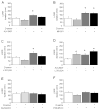Probing the modulation of acute ethanol intoxication by pharmacological manipulation of the NMDAR glycine co-agonist site
- PMID: 22934986
- PMCID: PMC3515721
- DOI: 10.1111/j.1530-0277.2012.01922.x
Probing the modulation of acute ethanol intoxication by pharmacological manipulation of the NMDAR glycine co-agonist site
Abstract
Background: Stimulating the glycine(B) binding site on the N-methyl-d-aspartate ionotropic glutamate receptor (NMDAR) has been proposed as a novel mechanism for modulating behavioral effects of ethanol (EtOH) that are mediated via the NMDAR, including acute intoxication. Here, we pharmacologically interrogated this hypothesis in mice.
Methods: Effects of systemic injection of the glycine(B) agonist, d-serine, the GlyT-1 glycine transporter inhibitor, ALX-5407, and the glycine(B) antagonist, L-701,324, were tested for the effects on EtOH-induced ataxia, hypothermia, and loss of righting reflex (LORR) duration in C57BL/6J (B6) and 129S1/SvImJ (S1) inbred mice. Effects of the glycine(B) partial agonist, d-cycloserine (DCS), the GlyT-1 inhibitor, N-[3-(4'-fluorophenyl)-3-(4'-phenylphenoxy)propyl]sarcosine (NFPS), and the glycine(B) antagonist, 5,7-dichlorokynurenic (DCKA), on EtOH-induced LORR duration were also tested. Interaction effects on EtOH-induced LORR duration were examined via combined treatment with d-serine and ALX-5407, d-serine and MK-801, d-serine and L-701,324, as well as L-701,324 and ALX-5407, in B6 mice, and d-serine in GluN2A and PSD-95 knockout mice. The effect of dietary depletion of magnesium (Mg), an element that interacts with the glycine(B) site, was also tested.
Results: Neither d-serine, DCS, ALX-5407, nor NFPS significantly affected EtOH intoxication on any of the measures or strains studied. L-701,324, but not DCKA, dose-dependently potentiated the ataxia-inducing effects of EtOH and increased EtOH-induced (but not pentobarbital-induced) LORR duration. d-serine did not have interactive effects on EtOH-induced LORR duration when combined with ALX-5407. The EtOH-potentiating effects of L-701,324, but not MK-801, on LORR duration were prevented by d-serine, but not ALX-5407. Mg depletion potentiated LORR duration in B6 mice and was lethal in a large proportion of S1 mice.
Conclusions: Glycine(B) site activation failed to produce the hypothesized reduction in EtOH intoxication across a range of measures and genetic strains, but blockade of the glycine(B) site potentiated EtOH intoxication. These data suggest endogenous activity at the glycine(B) opposes EtOH intoxication, but it may be difficult to pharmacologically augment this action, at least in nondependent subjects, perhaps because of physiological saturation of the glycine(B) site.
Copyright © 2012 by the Research Society on Alcoholism.
Figures




References
-
- Atkinson BN, Bell SC, De Vivo M, Kowalski LR, Lechner SM, Ognyanov VI, Tham CS, Tsai C, Jia J, Ashton D, Klitenick MA. ALX 5407: a potent, selective inhibitor of the hGlyT1 glycine transporter. Mol Pharmacol. 2001;60:1414–1420. - PubMed
-
- Backstrom P, Hyytia P. Ionotropic glutamate receptor antagonists modulate cue-induced reinstatement of ethanol-seeking behavior. Alcohol Clin Exp Res. 2004;28:558–565. - PubMed
-
- Backstrom P, Hyytia P. Ionotropic and metabotropic glutamate receptor antagonism attenuates cue-induced cocaine seeking. Neuropsychopharmacology. 2006;31:778–786. - PubMed
-
- Biala G, Kotlinska J. Blockade of the acquisition of ethanol-induced conditioned place preference by N-methyl-D-aspartate receptor antagonists. Alcohol Alcohol. 1999;34:175–182. - PubMed
-
- Bienkowski P, Danysz W, Kostowski W. Study on the role of glycine, strychnine-insensitive receptors (glycineB sites) in the discriminative stimulus effects of ethanol in the rat. Alcohol. 1998;15:87–91. - PubMed
Publication types
MeSH terms
Substances
Grants and funding
LinkOut - more resources
Full Text Sources

